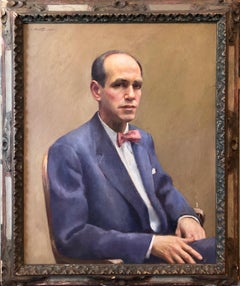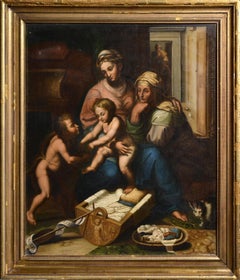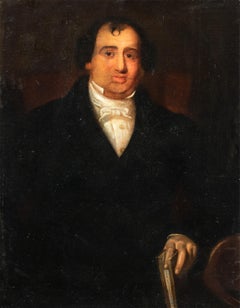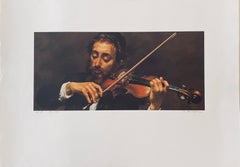Itshak Holtz Art
to
1
1
1
Overall Height
to
Overall Width
to
1
1
1
6,909
3,240
2,514
1,217
1
1
1
1
Artist: Itshak Holtz
Itzhak Holtz (Judaica Master) Oil Painting Portrait John Sloan Ashcan Artist WPA
By Itshak Holtz
Located in Surfside, FL
Oil Painting Portrait of Ashcan Artist John Sloan. Signed I. Holtz.
The youngest of four children, Holtz was born and spent his early childhood in Skierniewice, Poland, a small town near Warsaw. His father was a hat maker and a furrier. In 1935, prior to World War II, when Holtz was ten years old, his family moved to Jerusalem, Israel, where they settled in the Geula neighborhood near Meah Shearim.
Itzhak Holtz's passion for art began early. When he was five years old, in Poland, his father first drew a picture of a horse and sled in the snow for him. The young Holtz looked at the drawing and studied it in wonderment. From that moment on, Holtz remembers, he constantly begged his father to draw for him. His enthusiasm for art grew and Holtz longed to study art. In 1945, he enrolled at the Bezalel Academy of Art and Design in Jerusalem, where he primarily studied lettering and poster work in a program geared toward commercial art Holtz became interested in painting, prompting him to move to New York City in 1950 to study at the Art Students League of New York under Robert Brackman and Harry Sternberg, and then at the National Academy of Design under Robert Philipp.
Holtz has stated that his artwork, which primarily but not exclusively, depict scenes of Jewish spirituality and tradition, is driven by his Orthodox Jewish beliefs: "You have to live that religious life to fully capture it on canvas." He has been classified in the school of genre painting, often depicting street scenes of ordinary people in everyday Jewish life in the back alleys and markets of Jerusalem neighborhoods such as Me'ah Shearim and Geula; and in New York neighborhoods and hamlets such as Monsey, Boro Park and Williamsburg. Along with street scenes, his work includes portraits of scribes, tailors, cobblers and fishmongers, and images such as shtetls, lighthouses, and wedding scenes. He started out painting mostly portraits in order to support his family, before expanding to include street scenes. His beloved subject matter is painting scenes of Jewish life, his childhood memories when his mother took him along shopping for the Sabbath to the markets of Meah Shearim, has left a deep impression on him and influenced many of his works. Holtz has experimented in the abstract, but then reverted to representational and figurative art to which he devoted himself exclusively. His Israeli street scenes are said to combine “an affectionate recollection of the past with the brilliance of the color of modern Israel.”
Holtz has stated that he struggled at first when he arrived to the USA because of financial reasons and because he only knew Polish, Yiddish and Hebrew, but then made good ties with his instructor who greatly influenced him Robert Philipp who helped him make friends and referred him to paint portraits.
Examples of Holtz's work throughout the years include: Yerusalem Wedding (2010), depicting a Chuppa in Jerusalem on early evening, oil on canvas; The Funeral(1966), depicting five stoic Hasidim carrying a body on a bier over to a gravesite, with the people behind them crying, in charcoal on paper and oil on canvas; Rejoicing (1974), an image of religious men dancing, in felt pen and marker on paper; and the oil painting Shamash Learning in Shul (2003), a portrait of a pious Jew studying the Talmud inside a claustrophobic synagogue scene.
Throughout the years Holtz has created hundreds of works in many art mediums, including, genre scenes, portraits, still lifes and landscape scenery, his works are sought after by art collectors worldwide, and he has been called the greatest living Jewish artist. It is said that no artist ever explored the Jewish subject like Holtz. Today some of his oil paintings have been commanding over $100,000.
Holtz creates his scenes after researching locations, and often uses locals as models. He paints slowly and with great care, but with a swift Impressionistic style. The people in his portraits and scenes are generally more cheerful and optimistic than standard portraits of Hassidic individuals. He paints oils and watercolors, and also does felt pen, pastel, marker, ink and charcoal drawings, as well as woodcuts. His oil paintings typically have a brown hue, while his work with felt pen is often in sepia tones, and on some of his works he used very bright colors, with a strong emphasis on the interplay of light and shadow. He is heavily influenced by the ancient staircases and alleyways of Jerusalem, with its modest religious population, which has made a strong impression on him in his youth, the streets of Tzfat, and the works of Rembrandt, Johannes Vermeer and Peter Bruegel, as well as Jewish artists Moritz Daniel Oppenheim...
Category
1940s Realist Itshak Holtz Art
Materials
Canvas, Oil
Related Items
Holy Family with St Elizabeth and Young John Baptist 19th century Oil Painting
Located in Stockholm, SE
This tender depiction of the Holy Family represents a subject which was central to Raphael's oeuvre. The painting is based on the famous panel by Giulio Romano, called Madonna della ...
Category
Late 19th Century Realist Itshak Holtz Art
Materials
Canvas, Wood, Oil
Realist Italian painter - 19th century figure painting - Male Portrait
Located in Varmo, IT
Italian painter (19th century) - Portrait of a gentleman with a book.
92 x 71 cm.
Antique oil painting on canvas, without frame.
Condition report: Lined canvas. Good condition of ...
Category
Late 19th Century Realist Itshak Holtz Art
Materials
Canvas, Oil
H 36.23 in W 27.96 in
After Kupta, Portrait, Realism, Oil Painting, Texas Artist, Sawyer Yards
Located in Houston, TX
"After Kupta" 7 x 5 Framed 12 x 10
One of my favorite paintings is the Yellow Scales, a self portrait by Frantisek Kupka hanging in my home city museum, Houston Fine Arts, and whe...
Category
2010s Realist Itshak Holtz Art
Materials
Canvas, Oil
Portrait of a Woman "Irene Handl" with 1950s Style Outfit in Oil on Canvas
By Cindy Gin
Located in Soquel, CA
Portrait of a Woman with 1950s Style Outfit in Oil on Canvas
Elegant portrait of a woman (Irene Handl) with horn rimmed glasses by Cindy Gin (Cindy Lin) (American, 20th Century). Th...
Category
1990s Realist Itshak Holtz Art
Materials
Canvas, Oil
H 24 in W 18 in D 0.75 in
'Lady @ Bar' Contemporary, Colorful, Night Scene, Oil/Canvas by Andrew Jackson
By Andrew Jackson
Located in Carmel, CA
'Lady in bar' oil on canvas by Andrew Jackson
Working Fine Artist since 1991, Andrew Jackson brings to the Outer Edge Studio, his 20 year experience of...
Category
21st Century and Contemporary Realist Itshak Holtz Art
Materials
Oil, Canvas
H 20 in W 16 in D 0.75 in
Russian Traveler Genre Portrait 19th Century Oil Painting Signed Framed
Located in Stockholm, SE
The short signature lower left a monogram of joined Cyrillic letters "V" and "P" with date 77, leads to the Russian painter Vasily Dmitrievich Polenov (1844 - 1927). Here we have pl...
Category
Late 19th Century Realist Itshak Holtz Art
Materials
Wood, Canvas, Cotton Canvas, Oil, Cardboard
Staring - Contemporary, Figurative Art, Blue, Green, Yellow, Playground, Kids
Located in Berlin, DE
Staring, 2012
Oil on canvas (Signed on reverse)
19.68 H x 23.62 W in
50 H x 60 W cm
The painting represents two children in the playground. One child is painted eating a banana and...
Category
2010s Realist Itshak Holtz Art
Materials
Canvas, Oil
Free Shipping
H 22.84 in W 26.78 in D 3.15 in
[Bruce Sargeant (1898-1938)] Five Gymnasts in Training
By Mark Beard
Located in New York, NY
Oil on canvas
Signed in red, u.r.
$16,000.00 + framing
This artwork is offered by ClampArt, located in New York City.
“Bruce Sargeant is a mythic figure in the modern art movement...
Category
21st Century and Contemporary Realist Itshak Holtz Art
Materials
Canvas, Oil
Resilient Spirit
Located in Ibadan, Oyo
Resilient spirits celebrate the human spirit’s ability to overcome adversity, bounce back from failures, and continue to thrive. It depicts characters who face significant challenge...
Category
21st Century and Contemporary Realist Itshak Holtz Art
Materials
Mixed Media, Canvas, Oil, Acrylic
Men Deserve Flowers Too
Located in Ibadan, Oyo
Men have feelings and emotions. They need empathy and engagement. But we tell them, ‘Don’t be needy’ or ‘Don’t cry.’ We are pitting a male's neurobiology and human need for relations...
Category
21st Century and Contemporary Realist Itshak Holtz Art
Materials
Mixed Media, Canvas, Oil, Acrylic
Ewa - XXI Century, Contemporary Figurative Oil Painting, Realism, Portrait
By Janusz Szpyt
Located in Warsaw, PL
Janusz Szpyt was born in 1960, he is a Polish painter. He graduated from the Graphic design faculty and painting from the Academy of Fine Arts in Krakow. 1983 onward, he became the m...
Category
2010s Realist Itshak Holtz Art
Materials
Canvas, Oil
"Looking In the Mirror" Contemporary Portrait Oil n Canvas by Scott Jacobs
By Scott Jacobs
Located in Carmel, CA
"Looking in the mirror" oil on canvas by Jackson
The painting comes with a certificate of authenticity and a letter of appraisal.
Represented by American Art Gallery Carmel California
Category
21st Century and Contemporary Realist Itshak Holtz Art
Materials
Oil, Canvas
Previously Available Items
"The Violinist" Judaica Jewish Lithograph Signed Itshak Holtz
By Itshak Holtz
Located in Surfside, FL
The youngest of four children, Holtz was born and spent his early childhood in Skierniewice, Poland, a small town near Warsaw. His father was a hat maker and a furrier. In 1935, prior to World War II, when Holtz was ten years old, his family moved to Jerusalem, Israel, where they settled in the Geula neighborhood near Meah Shearim.
Itzhak Holtz...
Category
20th Century Realist Itshak Holtz Art
Materials
Lithograph
Itzhak Holtz (Judaica Master) Oil Painting Portrait John Sloan Ashcan Artist WPA
By Itshak Holtz
Located in Surfside, FL
Oil Painting Portrait of Ashcan Artist John Sloan. Signed I. Holtz.
The youngest of four children, Holtz was born and spent his early childhood in Skierniewice, Poland, a small town near Warsaw. His father was a hat maker and a furrier. In 1935, prior to World War II, when Holtz was ten years old, his family moved to Jerusalem, Israel, where they settled in the Geula neighborhood near Meah Shearim.
Itzhak Holtz's passion for art began early. When he was five years old, in Poland, his father first drew a picture of a horse and sled in the snow for him. The young Holtz looked at the drawing and studied it in wonderment. From that moment on, Holtz remembers, he constantly begged his father to draw for him. His enthusiasm for art grew and Holtz longed to study art. In 1945, he enrolled at the Bezalel Academy of Art and Design in Jerusalem, where he primarily studied lettering and poster work in a program geared toward commercial art Holtz became interested in painting, prompting him to move to New York City in 1950 to study at the Art Students League of New York under Robert Brackman and Harry Sternberg, and then at the National Academy of Design under Robert Philipp.
Holtz has stated that his artwork, which primarily but not exclusively, depict scenes of Jewish spirituality and tradition, is driven by his Orthodox Jewish beliefs: "You have to live that religious life to fully capture it on canvas." He has been classified in the school of genre painting, often depicting street scenes of ordinary people in everyday Jewish life in the back alleys and markets of Jerusalem neighborhoods such as Me'ah Shearim and Geula; and in New York neighborhoods and hamlets such as Monsey, Boro Park and Williamsburg. Along with street scenes, his work includes portraits of scribes, tailors, cobblers and fishmongers, and images such as shtetls, lighthouses, and wedding scenes. He started out painting mostly portraits in order to support his family, before expanding to include street scenes. His beloved subject matter is painting scenes of Jewish life, his childhood memories when his mother took him along shopping for the Sabbath to the markets of Meah Shearim, has left a deep impression on him and influenced many of his works. Holtz has experimented in the abstract, but then reverted to representational and figurative art to which he devoted himself exclusively. His Israeli street scenes are said to combine “an affectionate recollection of the past with the brilliance of the color of modern Israel.”
Holtz has stated that he struggled at first when he arrived to the USA because of financial reasons and because he only knew Polish, Yiddish and Hebrew, but then made good ties with his instructor who greatly influenced him Robert Philipp who helped him make friends and referred him to paint portraits.
Examples of Holtz's work throughout the years include: Yerusalem Wedding (2010), depicting a Chuppa in Jerusalem on early evening, oil on canvas; The Funeral(1966), depicting five stoic Hasidim carrying a body on a bier over to a gravesite, with the people behind them crying, in charcoal on paper and oil on canvas; Rejoicing (1974), an image of religious men dancing, in felt pen and marker on paper; and the oil painting Shamash Learning in Shul (2003), a portrait of a pious Jew studying the Talmud inside a claustrophobic synagogue scene.
Throughout the years Holtz has created hundreds of works in many art mediums, including, genre scenes, portraits, still lifes and landscape scenery, his works are sought after by art collectors worldwide, and he has been called the greatest living Jewish artist. It is said that no artist ever explored the Jewish subject like Holtz. Today some of his oil paintings have been commanding over $100,000.
Holtz creates his scenes after researching locations, and often uses locals as models. He paints slowly and with great care, but with a swift Impressionistic style. The people in his portraits and scenes are generally more cheerful and optimistic than standard portraits of Hassidic individuals. He paints oils and watercolors, and also does felt pen, pastel, marker, ink and charcoal drawings, as well as woodcuts. His oil paintings typically have a brown hue, while his work with felt pen is often in sepia tones, and on some of his works he used very bright colors, with a strong emphasis on the interplay of light and shadow. He is heavily influenced by the ancient staircases and alleyways of Jerusalem, with its modest religious population, which has made a strong impression on him in his youth, the streets of Tzfat, and the works of Rembrandt, Johannes Vermeer and Peter Bruegel, as well as Jewish artists Moritz Daniel Oppenheim, Tully Filmus, Leonid Pasternak and Isidor Kaufmann have had a strong influence on him. He has said that realism is the best way he can express himself.
John French Sloan (August 2, 1871 – September 7, 1951) was an American painter and etcher. He is considered to be one of the founders of the Ashcan school of American art. He was also a member of the group known as The Eight. He is best known for his urban genre scenes and ability to capture the essence of neighborhood life in New York City, often observed through his Chelsea studio window. Sloan has been called "the premier artist of the Ashcan School who painted the inexhaustible energy and life of New York City during the first decades of the twentieth century"and an "early twentieth-century realist painter who embraced the principles of Socialism and placed his artistic talents at the service of those beliefs." In the fall of 1884 he enrolled at the prestigious Central High School in Philadelphia, where his classmates included William Glackens and Albert Barnes. In 1892, he began working as an illustrator in the art department of The Philadelphia Inquirer. Later that same year, Sloan began taking evening classes at the Pennsylvania Academy of the Fine Arts under the guidance of the realist Thomas Anshutz.
In 1892, Sloan met Robert Henri, a talented painter and charismatic advocate of artistic independence who became his mentor and closest friend. Henri encouraged Sloan in his graphic work and eventually convinced him to turn to painting. They shared a common artistic outlook and in the coming years promoted a new form of realism, known as the "Ashcan school" of American art. In 1893, Sloan and Henri founded the short-lived Charcoal Club together, whose members would also include Glackens, George Luks, and Everett Shinn.
Sloan participated in the landmark 1908 exhibition at the Macbeth Galleries of a group that included four other artists from the Philadelphia Charcoal Club (Henri, Glackens, Luks and Shinn) as well as three artists who worked in a less realistic, more impressionistic style, Maurice Prendergast, Ernest Lawson, and Arthur B. Davies. The group was afterward collectively known as "The Eight." In 1922 he organized an exhibition of work by Native American artists at the Society of Independent Artists in New York. He also championed the work of Diego Rivera, whom he called "the one artist on this continent who is in the class of the old masters." The Society of Independent Artists, which Sloan had co-founded in 1916, gave Rivera and José Clemente Orozco their first showing in the United States in 1920.
In American Visions, the critic Robert Hughes praised Sloan's art for "an honest humaneness, a frank sympathy, a refusal to flatten its figures into stereotypes of class misery ... He saw his people as part of larger totality, the carnal and cozy body of the city itself." In American Painting from the Armory Show to the Depression, art historian Milton Brown called Sloan "the outstanding figure of the Ash Can School." To his friend, the painter John Butler Yeats...
Category
1940s Realist Itshak Holtz Art
Materials
Canvas, Oil
"Three Klezmer Musicians" Judaica Jewish Lithograph Signed Itshak Holtz
By Itshak Holtz
Located in Surfside, FL
The youngest of four children, Holtz was born and spent his early childhood in Skierniewice, Poland, a small town near Warsaw. His father was a hat maker and a furrier. In 1935, prior to World War II, when Holtz was ten years old, his family moved to Jerusalem, Israel, where they settled in the Geula neighborhood near Meah Shearim.
Itzhak Holtz...
Category
1960s Realist Itshak Holtz Art
Materials
Lithograph
Itshak Holtz art for sale on 1stDibs.
Find a wide variety of authentic Itshak Holtz art available for sale on 1stDibs. You can also browse by medium to find art by Itshak Holtz in canvas, fabric, oil paint and more. Not every interior allows for large Itshak Holtz art, so small editions measuring 30 inches across are available. Customers who are interested in this artist might also find the work of Dmitriy Krestniy, Doris Zinkeisen, and Adrienne Stein. Itshak Holtz art prices can differ depending upon medium, time period and other attributes. On 1stDibs, the price for these items starts at $8,000 and tops out at $8,000, while the average work can sell for $8,000.




